Monday, January 30, 2017
Friday, January 27, 2017
Teaching language via story telling.
Story telling seems to be hard wired into us and tapping that deeply rooted need is a great way to get students to be more creative and expressive in the foreign language they wish to learn. Nowadays, with the advent of ever cheaper hardware and a ready supply of free-to-use applications, the cost of using such equipment in lessons has dropped significantly.
Here is a teaching idea that utilises such opportunities. A number of different aspects of language can be practiced with this exercise and it encourages active production in written form while creating dialogues and via the recording section it encourages students to listen to themselves and change their performances in response.
This is a long term project that will need multiple lessons and much will be best assigned for homework, also it requires the teacher to be comfortable with the software used and so is not for the technologically faint hearted. However, to simplify the procedure the video segment could be omitted and student could record themselves on their smart phones.
The level of the lesson depends very much on the source material chosen but could range from near beginner to advanced.
You'll need:
-Access to PC with a microphone and speakers and ideally the internet (useful but not absolutely
necessary).
-Comics in digital form or scanned pages from regular comics
-Windows Movie Maker
-An image processing app/program such as Windows Paint./Photoshop or GIMP.
-Audacity a free audio editor and recorder program (Optional).
Many comics in digital form come in .CBR/CBZ and other similar formats which means you'll need a special program to read them on a PC e.g. Comic Book Reader. However, this format cannot be read by image processing programs, To make them compatible you'll have to decompress or "unzip" them. which you can easily do by right clicking with your mouse or touch pad the file you need and decompressing it.The result will be that every page will become a jpg image file which you can then use with the other programs mentioned here.
.
Lesson Plan
There are three possible options for this stage of the lesson, you can use a comic strip with no dialogue e.g. Tiny Titan's Beast Boy or you could use a strip with dialogue and either let students read existing dialogue or blank out the speech bubbles and let students replace it with their own - see Star Wars Rebels example.
Once again the choice of comic strip also will reflect what kind of language structure, and/or vocabulary is being practiced/taught. Also whether the project will be best done by individual students or in groups is on best decided by the teacher. The exercise is very open ended and can be adapted for any number of language teaching items. This plan is a general introduction to the concepts rather than a step-by-step guide. Also the burden of much of the preparation will have to be taken up by the teacher unless you want to spend hours explaining several different programs to your students.
Here is a teaching idea that utilises such opportunities. A number of different aspects of language can be practiced with this exercise and it encourages active production in written form while creating dialogues and via the recording section it encourages students to listen to themselves and change their performances in response.
This is a long term project that will need multiple lessons and much will be best assigned for homework, also it requires the teacher to be comfortable with the software used and so is not for the technologically faint hearted. However, to simplify the procedure the video segment could be omitted and student could record themselves on their smart phones.
The level of the lesson depends very much on the source material chosen but could range from near beginner to advanced.
You'll need:
-Access to PC with a microphone and speakers and ideally the internet (useful but not absolutely
necessary).
-Comics in digital form or scanned pages from regular comics
-Windows Movie Maker
-An image processing app/program such as Windows Paint./Photoshop or GIMP.
-Audacity a free audio editor and recorder program (Optional).
Many comics in digital form come in .CBR/CBZ and other similar formats which means you'll need a special program to read them on a PC e.g. Comic Book Reader. However, this format cannot be read by image processing programs, To make them compatible you'll have to decompress or "unzip" them. which you can easily do by right clicking with your mouse or touch pad the file you need and decompressing it.The result will be that every page will become a jpg image file which you can then use with the other programs mentioned here.
.
Lesson Plan
There are three possible options for this stage of the lesson, you can use a comic strip with no dialogue e.g. Tiny Titan's Beast Boy or you could use a strip with dialogue and either let students read existing dialogue or blank out the speech bubbles and let students replace it with their own - see Star Wars Rebels example.
Once again the choice of comic strip also will reflect what kind of language structure, and/or vocabulary is being practiced/taught. Also whether the project will be best done by individual students or in groups is on best decided by the teacher. The exercise is very open ended and can be adapted for any number of language teaching items. This plan is a general introduction to the concepts rather than a step-by-step guide. Also the burden of much of the preparation will have to be taken up by the teacher unless you want to spend hours explaining several different programs to your students.
You will need to cut up the comic strip into sets of one, two or three using your image processing program and then add these images to the the Windows Movie Maker program (Here is a video tutorial on how to use WWM). To add your dialogue to the video you can use the existing recorder function that WMM has or record them via Audacity, an excellent free to use studio recording program, in which case you'll need to add the audio files separately to your WMM project.
You'll then need to adjust the length of time the images stay on screen in order to fit images and dialogue (the video tutorial mentioned above explains how to do this)..
BE WARNED: Recording dialogue correctly is a time consuming process and your students will probably need multiple takes before you or they are happy with the final result. However, this is the heart of the exercise as it requires students to listen to themselves closely and correct any mistakes made in pronunciation. The time spent is well worth the results.
The downside is that older student often recoil from the sound of their own voice, the upside is that it makes them aware of long term issues and allows them to improve enormously.
Instead of using comics, you could also use children's books or pages from a school text book.
Sunday, January 22, 2017
Friday, January 20, 2017
Energy poverty and pollution in Greece
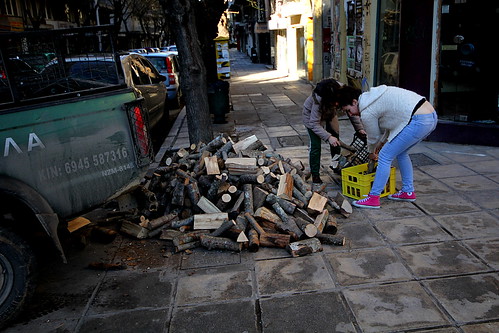
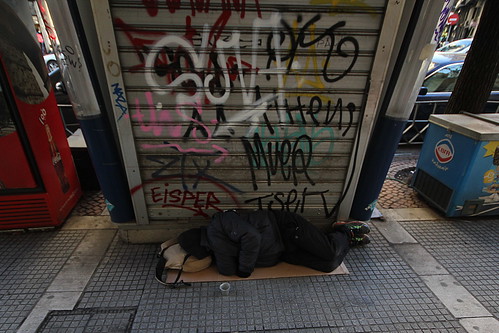
One of the symptom or perhaps better put, a victim of the economic crisis in Greece is air quality, especially in large cities such as Athens and Thessaloniki as people switch from using heating oil and electricity to burning wood in order to heat their homes.
The government's attempt to claw in revenue by massively increasing taxation on the heating oil that used to be the staple of central heating boilers in many urban apartment blocks has seen many residents abandon them, unable to pay for the oil that fuelled them. In addition, in Greece people are wary of running up massive electricity bills and so are loathed to rely just on it for heating.
In their place many people have returned to traditional wood burning stoves which produce far more air pollution than other forms of heating and in built up urban areas have led to a serious decline in air quality, especially when combined with other sources of smog such as car exhaust fumes.
The recent bitterly cold spell in Greece dramatically brought to the fore energy poverty, yet another entry in a long list of woes that Greeks have had to face since the start of the economic crisis in 2009. Even after years of supposed bail outs and mandated economic "adjustments" (Read cuts in health, educational spending, pensions etc) the economy continues to wither and die on the vine, starved on capital and the prospect of improvement any time soon.
Snow bound Thessaloniki
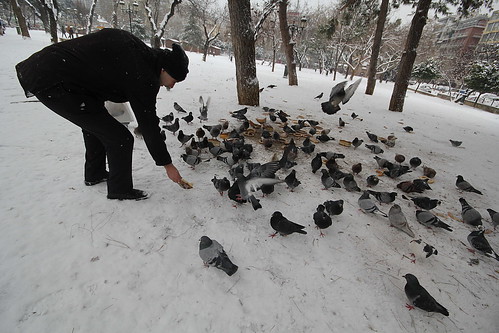
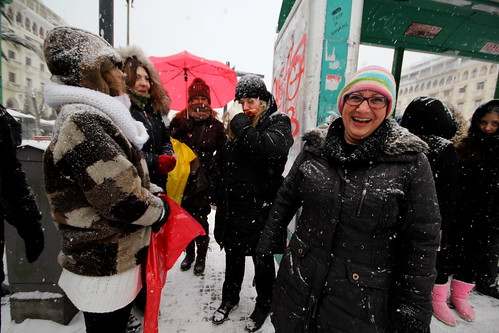
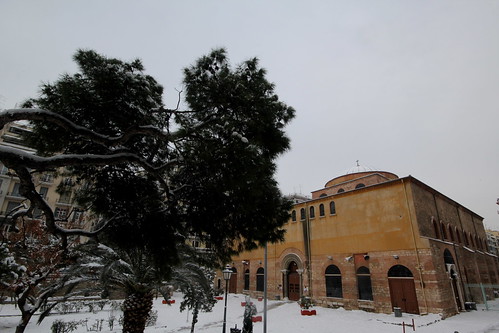
Thankfully, the worst of the recent cold snap is over here in Thessaloniki. Last week temperatures nose dived far below zero and the city was blanketed with snow for the first time in years, According to some accounts it was coldest spell Thessaloniki has experienced since the 1930s. As result many were left without heating and water as gas and water pipes froze then cracked open. To add to people's woes electricity supplies were affected in many areas, making for a particularly miserable week for some.
Thursday, January 12, 2017
The winter crisis in Greece - refugees left in limbo as those in charge pass the buck
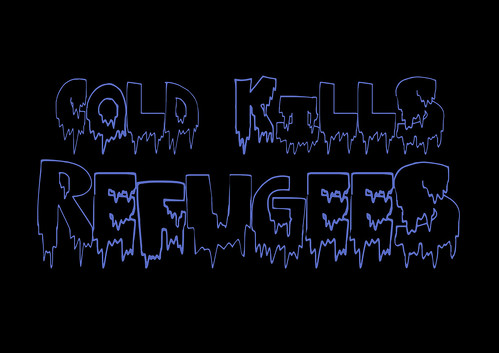
After days of anticipation, the Ariadni cold wave finally hit Greece a few days ago bring polar temperatures and heavy snowfall across across the country. Not only was this spate of bad weather predicted days in advance, it was the butt of many jokes and sarcastic comments on Facebook and Twitter as the full force of the front hit nearly two days later than had been originally forecast. So why the Greek authorities and the large international NGOs who help run many of the camps were taken so completely by surprise by the event is something of a surprise in itself. While many ordinary Greeks were left without water and electricity by the extreme cold, those worst hit were many of the 60,000 refugees still living in tents and abandoned industrial buildings in makeshift camps.
On the Greek islands of Lesbos, Chios and Samos some refugees were left to spend days in unheated tents enduring temperatures as low as -5C , Nor was it only the islands that saw such squalid neglect of people in dire need. Despite repeated assurances by Greece' Migration minister, Yannis Mouzalas that, with a few minor exceptions that those on the mainland were already in properly "winterised" accommodations (see his interview in the Turkish daily Hurriyet) photographs and video soon appeared on both Facebook and Twitter from volunteers and aid workers on the ground showing freezing families in snow covered tents and freezing warehouses struggling to survive polar temperatures.
Once the story was picked up by the international media the Greek government's response was to first ban photography and filming in the worst effected camps (refugee camps are under the control of either the Greek army or police force and access to them is strictly regulated) and then slowly place a minority (500 out of nearly 6,000) of the most vulnerable in more suitable housing, at least until the worst of the winter weather abated.
While the severity of the cold spell is unusual for Greece, it is not unprecedented, Greek winters especially in the north are shorter than those in northern Europe but are often quite severe due to the mountainous topography of the region, so much so that the nation has over 25 ski resorts that people flock to every year. Even on the islands winter temperatures are often no more clement than those in some parts of northern Europe such as southern UK and Ireland, even in a mild winter. Forcing people to live in tents and abandoned buildings for months in such conditions is nothing short of criminal.
As is so often the case, finding the villain of the piece is a complicated, frustrating process with all the major players, Greek central government, local authorities, EU and UNHCR Greece busily blaming each other for this easily avoided fiasco. In the meantime many refugee still find themselves in cold, squalid camps waiting for a plan to improve the situation that no one in a position of authority seems willing to provide.
Labels:
ariadni,
Athens,
Chios,
eu,
Greece,
greek islands,
lesbos,
mouzalas,
refugee housing,
refugees,
refugees crisis,
samos,
snow,
unhcr
Subscribe to:
Comments (Atom)



